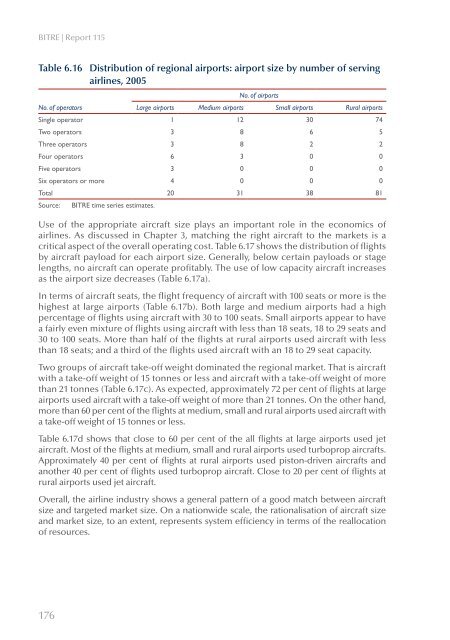PDF: 5191 KB - Bureau of Infrastructure, Transport and Regional ...
PDF: 5191 KB - Bureau of Infrastructure, Transport and Regional ...
PDF: 5191 KB - Bureau of Infrastructure, Transport and Regional ...
- No tags were found...
You also want an ePaper? Increase the reach of your titles
YUMPU automatically turns print PDFs into web optimized ePapers that Google loves.
BITRE | Report 115Table 6.16 Distribution <strong>of</strong> regional airports: airport size by number <strong>of</strong> servingairlines, 2005No. <strong>of</strong> airportsNo. <strong>of</strong> operators Large airports Medium airports Small airports Rural airportsSingle operator 1 12 30 74Two operators 3 8 6 5Three operators 3 8 2 2Four operators 6 3 0 0Five operators 3 0 0 0Six operators or more 4 0 0 0Total 20 31 38 81Source: BITRE time series estimates.Use <strong>of</strong> the appropriate aircraft size plays an important role in the economics <strong>of</strong>airlines. As discussed in Chapter 3, matching the right aircraft to the markets is acritical aspect <strong>of</strong> the overall operating cost. Table 6.17 shows the distribution <strong>of</strong> flightsby aircraft payload for each airport size. Generally, below certain payloads or stagelengths, no aircraft can operate pr<strong>of</strong>itably. The use <strong>of</strong> low capacity aircraft increasesas the airport size decreases (Table 6.17a).In terms <strong>of</strong> aircraft seats, the flight frequency <strong>of</strong> aircraft with 100 seats or more is thehighest at large airports (Table 6.17b). Both large <strong>and</strong> medium airports had a highpercentage <strong>of</strong> flights using aircraft with 30 to 100 seats. Small airports appear to havea fairly even mixture <strong>of</strong> flights using aircraft with less than 18 seats, 18 to 29 seats <strong>and</strong>30 to 100 seats. More than half <strong>of</strong> the flights at rural airports used aircraft with lessthan 18 seats; <strong>and</strong> a third <strong>of</strong> the flights used aircraft with an 18 to 29 seat capacity.Two groups <strong>of</strong> aircraft take-<strong>of</strong>f weight dominated the regional market. That is aircraftwith a take-<strong>of</strong>f weight <strong>of</strong> 15 tonnes or less <strong>and</strong> aircraft with a take-<strong>of</strong>f weight <strong>of</strong> morethan 21 tonnes (Table 6.17c). As expected, approximately 72 per cent <strong>of</strong> flights at largeairports used aircraft with a take-<strong>of</strong>f weight <strong>of</strong> more than 21 tonnes. On the other h<strong>and</strong>,more than 60 per cent <strong>of</strong> the flights at medium, small <strong>and</strong> rural airports used aircraft witha take-<strong>of</strong>f weight <strong>of</strong> 15 tonnes or less.Table 6.17d shows that close to 60 per cent <strong>of</strong> the all flights at large airports used jetaircraft. Most <strong>of</strong> the flights at medium, small <strong>and</strong> rural airports used turboprop aircrafts.Approximately 40 per cent <strong>of</strong> flights at rural airports used piston-driven aircrafts <strong>and</strong>another 40 per cent <strong>of</strong> flights used turboprop aircraft. Close to 20 per cent <strong>of</strong> flights atrural airports used jet aircraft.Overall, the airline industry shows a general pattern <strong>of</strong> a good match between aircraftsize <strong>and</strong> targeted market size. On a nationwide scale, the rationalisation <strong>of</strong> aircraft size<strong>and</strong> market size, to an extent, represents system efficiency in terms <strong>of</strong> the reallocation<strong>of</strong> resources.176
















